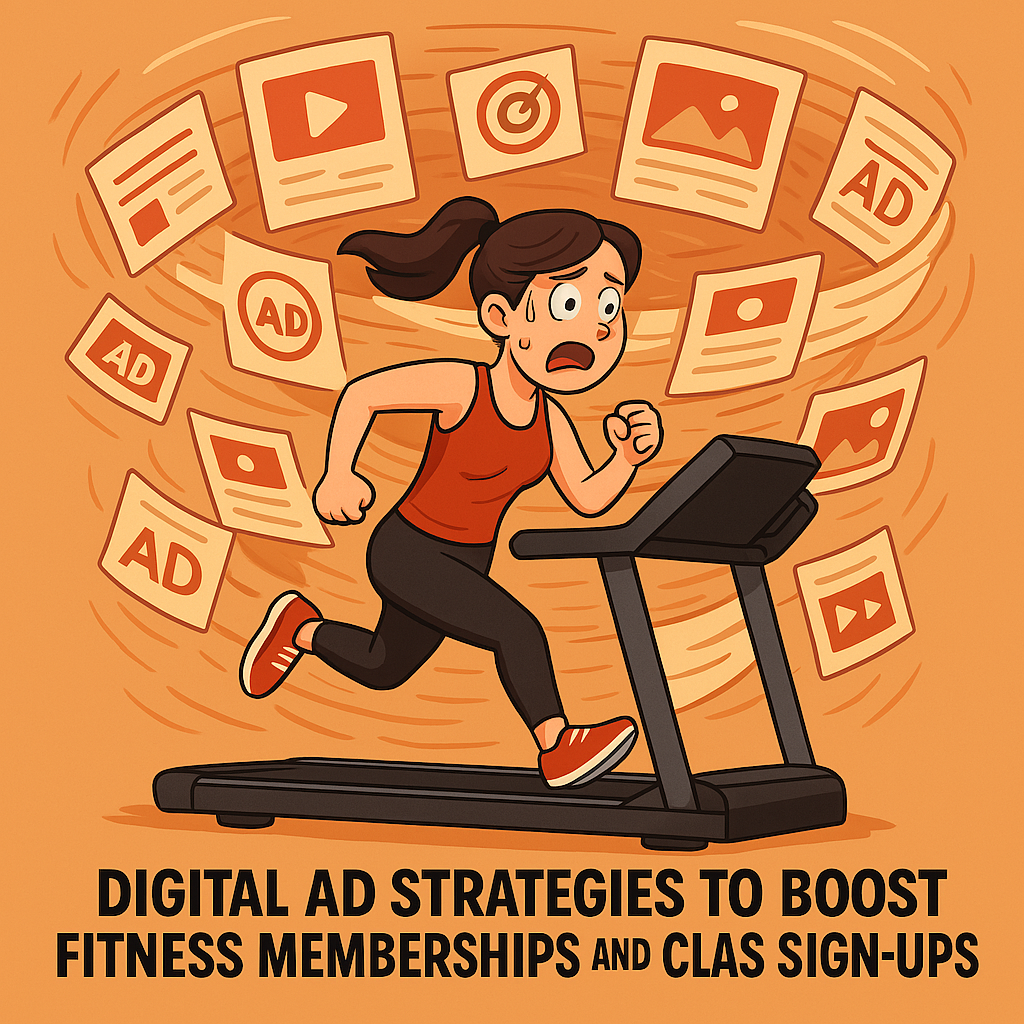As consumer interest in health and wellness continues to rise, fitness businesses—gyms, yoga studios, bootcamps, pilates centers, and virtual training platforms—have a major opportunity to grow. However, the days of relying solely on walk-ins, flyers, and referral programs are over. Today’s fitness customers are digitally savvy, comparison shoppers who demand convenience, relevance, and results. To reach them effectively, digital advertising must be a cornerstone of your marketing strategy.
In this comprehensive guide, we explore proven digital advertising strategies that drive fitness memberships and class sign-ups. Whether you’re a boutique fitness studio or a nationwide gym chain, these strategies will help you attract high-intent leads, build trust, and maximize ROI.
1. Know Exactly Who You’re Targeting
Effective digital marketing begins with clearly defining your target audience. Generic campaigns cast too wide a net and often fail to connect with the people most likely to sign up. You need to understand your audience’s age, gender, lifestyle, location, fitness goals, and even their digital behavior. For example, busy professionals in their 30s might be looking for flexible lunchtime workouts, while new moms could be seeking postnatal fitness classes that include child-friendly amenities. By drilling down into these details, you can craft messaging that speaks directly to their needs and preferences. Tailoring your campaigns in this way not only increases relevance but significantly boosts engagement and conversion rates.
Key Takeaways:
-
Narrow audience segments by fitness goal, behavior, and location to increase ad relevance and ROI.
-
Use tools like Facebook Audience Insights and Google Analytics to build and refine personas.
-
Personalized ads are 80% more likely to convert than generic ads (Instapage, 2023).
-
Include visuals and copy that reflect your target demographic’s lifestyle to improve engagement.
2. Geofencing Marketing for Hyperlocal Reach
Geofencing Marketing is an incredibly effective strategy for local fitness businesses. This location-based marketing approach allows you to draw digital perimeters around specific physical locations, such as competing gyms, cafes, college campuses, or office parks. When people enter these zones, they receive targeted ads on their mobile devices encouraging them to visit your gym or studio. Imagine someone exiting a rival gym and receiving a compelling message about a free trial at your nearby facility—that’s geo-fencing in action. It’s an ideal way to intercept potential members when they’re already in the mindset for fitness, helping you capitalize on proximity and intent.
Key Takeaways:
-
Geo-fencing can increase foot traffic by up to 25% when implemented around competitor locations.
-
Target users in real-time near gyms, health stores, universities, or workplaces for best results.
-
Create mobile-optimized ads that emphasize proximity and convenience.
3. Retargeting: Don’t Let Warm Leads Go Cold
Visitors to your website or landing page may not convert on their first visit, but that doesn’t mean they’re lost forever. Retargeting allows you to continue engaging those warm leads by showing them follow-up ads across the web or on social platforms. If someone checked your class schedule but didn’t register, a reminder ad offering a limited-time discount can nudge them back. Retargeting campaigns can be customized based on the user’s behavior, such as which pages they visited or how long they stayed. This approach helps reinforce your brand, improve recall, and increase the likelihood of conversion without the higher cost of acquiring brand-new leads.
Key Takeaways:
-
Retargeting increases conversion rates by 70% compared to non-retargeted traffic (Criteo, 2022).
-
Serve dynamic ads that reflect previous site activity, such as class views or pricing page visits.
-
Limit retargeting frequency to avoid ad fatigue; 7–12 touchpoints is ideal before conversion.
-
Use segmentation to tailor remarketing ads by interest (e.g., yoga, HIIT, personal training).
4. Run Google Search Ads for High-Intent Leads
Google Search Ads are one of the most powerful tools in your advertising toolkit, especially when your goal is to capture high-intent leads. When someone searches for terms like “best gym near me” or “kickboxing classes in [city],” they are actively looking for a solution you provide. By targeting these keywords with tailored ads, you place your business right in their path at the exact moment they’re ready to act. To make the most of search advertising, use long-tail keywords that are specific and location-based. Ensure your ad copy matches your landing page content and includes clear calls-to-action, making it easy for users to follow through on their interest.
Key Takeaways:
-
Google Ads capture bottom-of-funnel users who are actively searching for fitness solutions.
-
Ads with location-based long-tail keywords yield higher CTRs (avg. 6.48% vs. 3.17%, Wordstream).
-
Include sitelinks and call extensions to increase ad real estate and engagement.
-
Align search ad messaging with landing page content for higher Quality Scores and lower CPC.
5. Use Social Media Ads to Capture Attention and Inspire Action
Visual storytelling is vital in the fitness world, and social media platforms like Instagram, Facebook, TikTok, and YouTube provide the perfect space to bring your brand to life. Effective social media ads go beyond flashy graphics. They highlight real people, authentic transformations, and high-energy workouts that capture attention within seconds. A video showing a class in progress, a trainer offering a quick tip, or a member sharing their fitness journey adds a layer of credibility that polished stock photos cannot. These ads should focus on emotion and community while also offering a clear value proposition—such as a free trial or a new class schedule—to entice immediate engagement.
Key Takeaways:
-
Facebook and Instagram ads with video outperform static ads by 34% in the fitness niche (Meta internal data).
-
Use short-form video (15–30 seconds) to highlight energy, member stories, and community.
-
Reels and TikToks with trending audio and authentic moments increase organic reach.
-
Invest in creator partnerships or micro-influencers for UGC-style content and credibility.
6. Offer Incentives That Convert and Add Urgency
Promotional offers are a proven way to lower the barrier to entry and entice new members. Whether it’s a free class, discounted membership for the first month, or a bring-a-friend promotion, incentives give prospects a reason to try your facility with little to no risk. However, it’s equally important to pair these offers with urgency. Limited-time deals, countdown timers, or emphasizing that space is limited can significantly boost conversions. Urgency creates a sense of scarcity that motivates people to act quickly rather than postpone their decision. A well-timed offer, reinforced through digital ads, can push undecided prospects across the finish line.
Key Takeaways:
-
Free trials or first-class discounts reduce hesitation and improve conversion by up to 60% (Fitness Texter).
-
Pair offers with time-sensitive language: “expires soon,” “limited spots,” or countdown timers.
-
Track offer performance across ad channels to find your most effective incentive.
-
Use scarcity wisely—false urgency can harm brand trust if overused.
Want to learn more about CTA writing? Check out this article.
7. Scale With Lookalike Audiences
If you’ve already built a solid foundation of members or leads, Lookalike Audiences offer a powerful way to expand. Using data from your current clients, platforms like Facebook and Instagram can find new people who share similar characteristics and behaviors. This method allows you to scale your campaigns efficiently while maintaining a high degree of relevance. For instance, if your core members are young professionals in urban areas who attend HIIT classes, lookalike targeting will help you find more users likely to be interested in the same offerings. It’s a smarter way to grow your audience without wasting ad spend on less-qualified leads.
Key Takeways:
-
Lookalike Audiences are 2x more effective than broad demographic targeting (Meta Benchmark Report).
-
Use email lists of high-value clients or recent converters as the source audience.
-
Refine your seed list regularly to keep lookalike models fresh and high-quality.
-
Test 1%, 2%, and 5% similarity audiences to find the best balance of reach and performance.
8. Optimize Landing Pages for Maximum Conversions
Your digital ads are only as effective as the landing pages they link to. If someone clicks an ad but lands on a confusing, slow-loading page, they’re unlikely to convert. Optimizing your landing pages means removing friction and making the path to sign-up as intuitive as possible. Headlines should be clear and aligned with the ad that brought them there. The call-to-action should be visible immediately, preferably above the fold. Use compelling imagery and testimonials to build trust, and ensure the entire experience is mobile-friendly. Every element should reinforce your offer and guide the user toward a single, decisive action.
Key Takeaways:
-
Landing pages should load in under 3 seconds; 53% of mobile users abandon if it takes longer (Google, 2023).
-
Keep the design clean, mobile-friendly, and focused on a single CTA above the fold.
-
Use trust signals—client reviews, certifications, and social proof increase credibility.
-
A/B test CTA text (“Join Free” vs. “Claim Offer Now”) for measurable performance differences.
9. Incorporate YouTube Ads to Build Awareness
YouTube is an ideal platform for fitness brands to build top-of-funnel awareness. With billions of users and extensive targeting capabilities, it allows you to introduce your brand to a wide but relevant audience. Use short, energetic bumper ads to promote special events or new classes, or invest in longer in-stream ads to share member success stories and showcase your facility. The key to YouTube advertising is storytelling. Rather than a hard sell, focus on connecting with viewers emotionally and visually. Once engaged, you can bring them deeper into your marketing funnel through retargeting or email follow-up.
Key Takeaways:
-
YouTube reaches more adults aged 18–49 than any broadcast or cable TV network (Google).
-
Bumper ads (6 seconds) boost brand recall by 30%, especially for fitness offers.
-
Pair awareness campaigns with remarketing to nurture top-of-funnel leads.
-
Showcase emotion, transformation, or mission—not just workouts—for better storytelling.
10. Measure Everything and Optimize Weekly
Successful digital advertising is never static. The platforms, audiences, and creative trends evolve constantly, which means your strategies should, too. Regularly monitor metrics like click-through rate, cost-per-lead, landing page conversion rate, and return on ad spend. These data points tell the story of what’s working and what’s not. Weekly optimization can include pausing underperforming ads, reallocating budgets, testing new copy or creative, and refining targeting parameters. Over time, this ongoing process helps you maximize efficiency, lower acquisition costs, and maintain a competitive edge in your market.
Key Takeaways:
-
Monitor key metrics: CTR, conversion rate, cost-per-lead (CPL), and ROAS.
-
Adjust campaigns weekly—data-driven optimization improves performance over time.
-
Use tools like Google Analytics 4, Meta Ads Manager, and Hotjar for granular insights.
-
Avoid vanity metrics (likes, impressions); focus on outcomes like trial sign-ups or bookings.
11. Automate Lead Nurturing with Email and CRM
Digital ads are excellent for getting initial attention, but what happens next is equally critical. Integrating your advertising campaigns with an email marketing platform or CRM ensures that no lead falls through the cracks. When someone signs up for a free trial or fills out a form, an automated workflow should welcome them, share additional benefits, and invite them to take the next step. Timely follow-ups via email or SMS can increase engagement, reduce no-shows, and turn a trial visit into a long-term membership. Automation improves customer experience and allows your team to provide more in-person service.
Key Takeaways:
-
Automated follow-up increases conversions by up to 47% compared to manual responses (Campaign Monitor).
-
Segment leads by behavior—class interest, form completion, or location—to personalize nurture flows.
-
Email + SMS reminders reduce no-show rates for free trials and consultations.
-
Use CRM triggers to send timely nudges, like “It’s been 3 days since your first class—ready to commit?”
12. Time Campaigns with Seasons and Lifestyle Trends

Timing your campaigns around seasonal trends and lifestyle moments can significantly improve performance. For instance, the New Year is a prime time for fitness sign-ups, but there are also other key periods, such as spring break preparation, back-to-school transitions, and stress relief during the holidays. Consider tailoring your offers and messaging to what your audience is feeling at that time of year. You can also build lifestyle-based campaigns that target specific groups, such as busy professionals looking for express workouts or new parents needing flexible class schedules. Contextual relevance makes your messaging feel timely and personal, which leads to higher engagement.
Key Takeaways:
-
January, spring break, and post-summer are peak seasons for fitness sign-ups—plan ads accordingly.
-
Align messaging with current habits: “Back to School, Back to You” or “Holiday Stress Relief Workouts.”
-
Seasonal relevance can boost engagement by 20–30% over evergreen campaigns (HubSpot).
-
Use weather, holidays, or cultural trends to connect emotionally with audiences.
Case Studies: Real-World Success Stories
Implementing strategic digital advertising techniques has proven highly effective for fitness-related businesses. Below are two case studies demonstrating how targeted digital ad strategies significantly boosted memberships and sales.
Case Study 1: Health Club Achieves 25% Increase in Membership Sales
Challenge: A local health club aimed to increase memberships within an eight-mile radius but faced challenges with previous digital strategies that failed to yield a positive return on investment.
Solution: Two targeted campaigns were launched:
- No Enrollment Fee Campaign: Targeted users within the specified radius, promoting a waiver of enrollment fees.
- Swim Classes Promotion: Focused on local parents, highlighting available swim classes for children.
Results:
- Achieved the highest membership sales for March in the past twelve years.
- All swim classes reached full capacity in record time.
This case underscores the effectiveness of localized, incentive-based digital advertising in driving membership growth.
Case Study 2: Sports Apparel Brand Expands Audience with Geofencing and Display Advertising
Challenge: An online sports apparel brand sought to reach new audiences and increase sales through innovative digital marketing strategies.
Solution: Implemented geofencing marketing and programmatic display advertising to target potential customers based on their physical locations and online behaviors.
Results:
- Delivered over 3.7 million impressions and more than 4,700 clicks, achieving a click-through rate 30% above the industry average.
- Reported the best sales months were reported during November and December 2023.
This case illustrates how advanced targeting techniques like geofencing can effectively expand a brand’s reach and drive significant sales growth.
These examples demonstrate the tangible benefits of employing strategic digital advertising methods to enhance visibility and increase memberships or sales within the fitness industry.
Final Thoughts
The fitness industry is highly competitive, but it’s also full of opportunity. With the right digital advertising strategies, you can stand out, connect with your ideal clients, and grow your membership base steadily. From geo-fencing and retargeting to seasonal campaigns and CRM integration, every strategy in this guide is designed to meet prospects where they are and guide them toward becoming loyal members. Stay consistent, keep testing, and always prioritize the user experience. That’s how you turn interest into impact and clicks into committed clients.
🚨 Still Boosting Posts and Hoping for Sign-Ups?
Let’s be real—hope isn’t a strategy. If you’re tired of spinning your wheels with digital ads that don’t move the needle, it’s time to call in the experts. 
Book a FREE 30-minute strategy session with a Propellant Media pro. We’ll break down what’s holding your campaigns back and show you how to start driving real memberships and class sign-ups—no fluff, just results.
👉 Grab Your Spot Now – before your competition does.

